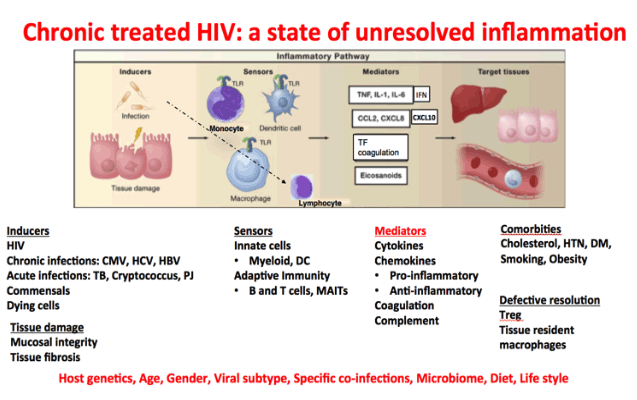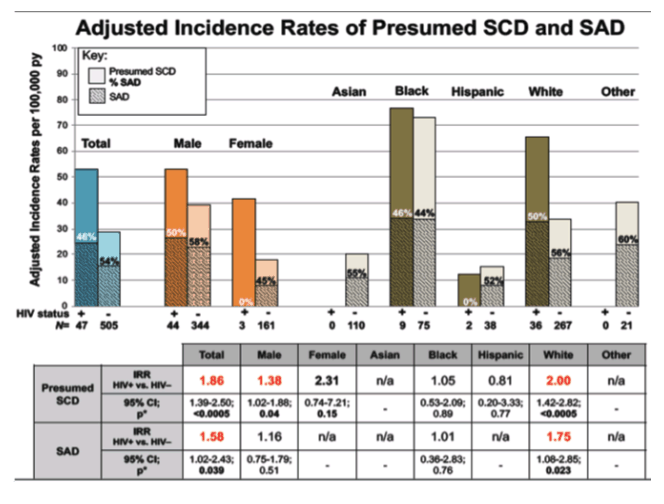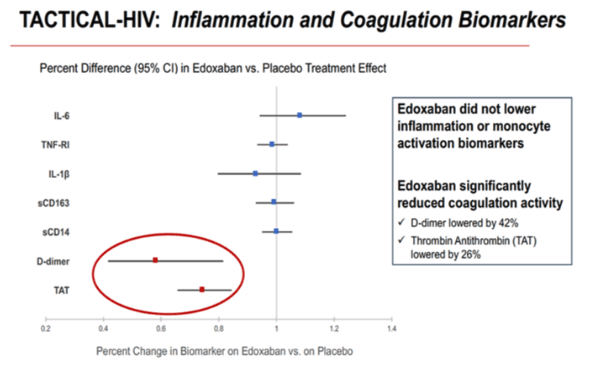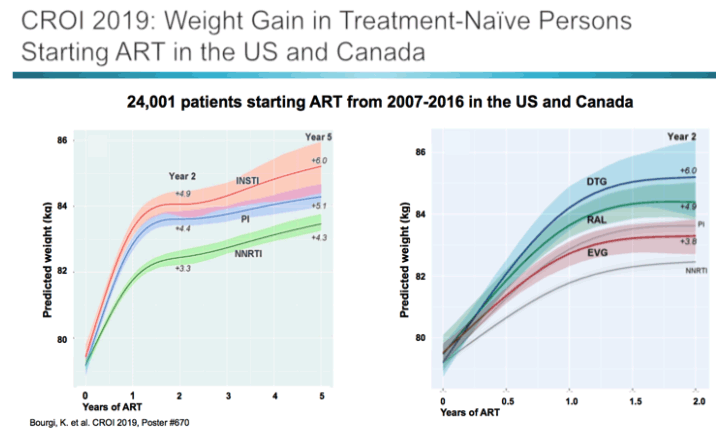 |
 |
 |
| |
Cardiovascular Update from CROI 2019
|
| |
| |
by Priscilla Hsue MD Professor of Medicine, UCSF
Studies evaluating cardiovascular disease among persons living with HIV continued to be a strong area of focus at the Conference on Retroviruses and Opportunistic Infections held in Seattle, Washington in in March 2019. While much of the focus was on “London patient” who may have achieved HIV remission, the meeting started with a plenary presentation by Dr. Irini Sereti entitled Inflammation: Taming the Flames (Abstract 13; which highlighted the role of chronic inflammation/immune activation in increased risk for both AIDS and non-AIDS events including CVD, as shown in her presentation below.
The role of chronic inflammation and immune activation in comorbidities was highlighted along with the need to understand the complex pathways that lead to chronic inflammation as well as the impact of therapeutic strategies.

http://www.croiwebcasts.org/console/player/41043?mediaType=audio&&crd_fl=0&ssmsrq=1561824391504&ctms=5000&csmsrq=5057
Several studies were focused on CVD during the oral presentations with a focus on sudden cardiac death and the impact of oral anticoagulants on inflammation. Dr. Freiberg (Abstract 32), presented a study of over 144,000 individuals in the Veteran Aging Cohort study which included 30% HIV-infected individuals, sudden cardiac death (SCD) was ascertained using death certificates and manual review of the VA EHR. After adjustment for demographics and risk factors for SCD, HIV-infected Veterans had a 14% higher risk of SCD as compared to uninfected individuals and the risk was highest among individuals with high HIV RNA levels or low CD4 cell counts.

The underlying mechanism of sudden death were presented by Dr. Tseng from UCSF (Abstract 33) in the HIV POST SCD Study which was a prospective evaluation of all incident deaths that were attributable to sudden cardiac death in San Francisco from 2011-2016. Around half of SCD in HIV were confirmed by autopsy which was similar to the uninfected population. Adjusted incidence ratios for autopsy confirmed arrhythmic death were over 80% higher in HIV, and higher levels of cardiac fibrosis, a substrate for sudden arrhythmic death, were demonstrated in this setting. Prolonged QT interval which can increase arrhythmia was reported among persons living with HIV which may be related to prior MI (Abstract 667); similarly, myocardial inflammation myocardial fibrosis as assessed by cardiac magnetic resonance was higher in HIV among individuals in South Africa (Abstract 660).
Sudden cardiac death risk higher with HIV--but not with sustained HIV control / "Sudden cardiac death among HIV-infected and -uninfected veterans" - (03/05/19)
2 Studies on Sudden Cardiac Death in HIV+ at CROI 2019 with surprising findings regarding causes of deaths - (04/28/19)
In Abstract 36, Dr. Baker evaluated the impact of edoxaban, a direct factor Xa inhibitor, in a cross over clinical trial of forty individuals treated for 4 months. Edoxaban was associated with a significant reduction in coagulation activity including a 42% reduction in D-dimer, but there was no impact on inflammatory markers. As expected, the medication was associated with increased risk for bleeding events.

Edoxaban lowers coagulation but not inflammation in people on ART - Mark Mascolini (03/07/19)
Among individuals from the CFAR CNICS cohort, COPD was independently associated with increased risk for MI in PLWH; of note, this finding was driven by Type II MI (demand related as opposed to atherothrombotic). (Abstract 31). In contrast mild alcohol use was protective for Type 1 MI using this same cohort (Abstract 665); rates of both type of MI (Type 1 and Type 2) were higher among older persons living with HIV (Abstract 664).
COPD doubles heart attack risk with HIV regardless of smoking / "COPD and the risk of MI by type in people living with HIV" - (03/05/19)
A monoclonal antibody that inhibits IL-6, tocilizumab, was associated with an increase in plasma concentrations of total lipids as well as the concentration of lipid species assessed using mass spectrometry (Abstract 647). An anti-CMV therapeutic strategy using valganciclovir reduced some markers of inflammation and vascular function, namely, TNF-R2 and sICAM-1 (Abstract 643).
Effect of newer antiretroviral therapies on traditional risk factors, inflammation, and CV risk were evaluated in a variety of studies. In Abstract 652, using the OPERA database (US persons living with HIV), individuals on TDF who switched to TAF had an increase in total cholesterol, LDL-C and triglycerides along with a decrease in HDL. This finding was present in a subgroup of individuals who switched from TDF to TAF but kept the other ART components the same. Another study of individuals who were initially switched from TDF to TAF and then were changed back from TAF to TDF demonstrated that the increase in TC and TG observed in the setting of TDF to TAF was reversible after changing back to TDF in around 1/3 of individuals (Abstract 651). TDF-diphosphate levels in dried blood were associated with higher markers of inflammation/immune activation (Abstract 657).
Changes in Lipids After a Direct Switch from TDF to TAF (03/08/19)
Beyond traditional risk factors, assessments of the viral reservoir were demonstrated to be independently predictive of incident plaque (Abstract 642) while plasma tissue factor along with higher levels of CD8+ T cell activation were independently predictive of IMT progression in treated HIV (Abstract 644). Novel biomarkers were also evaluated by several studies including an isoform of IL-32 (Abstract 632), cholesterol efflux capacity (Abstract 648), IL-10 (Abstract 634), transcriptomic biomarkers (Abstract 658), and advanced glycation end products (Abstract 656).
Weight gain and obesity in the setting of ART was an evolving theme this year which included weight gain in setting of integrase inhibitor therapy as reviewed by Dr. Koethe in his plenary session (Obesity: A growing Problem in Antiretroviral Therapy, Abstract 158).

PLENARY TALK - Obesity & Weight Gain on Antiretroviral Therapy – John Koethe (03/11/19)
However there may be differential effects upon weight within ART class; namely, cabotegravir (oral and injectable for total of 41 weeks) was not associated with weight in a placebo controlled study of uninfected individuals (Abstract 34).
A study of commercially insured and Medicaid covered PLWH newly initiated on ART, integrase based regimens were associated with a 43% decreased risk of CVD as compared to non-integrase based regimens (HR 0.57; 95% CI 0.45, 0.73, Abstract 680).
The impact of traditional risk factors in HIV was reported in several studies. In the SEARCH Study, persons with HIV were more likely to have controlled blood pressure compared to uninfected individuals (adjusted OR of 1.33, 95%CI 1.00 to 1.77), demonstrating that an integrated model for providing healthcare and drug supply can impact CV risk (Abstract 668). Of note, in a retrospective study in two academic centers in the Southeast, many HIV-infected individuals did not meet evidence-based treatment goals for hypertension and/or hyperlipidemia which may be impacted by the speciality of the provider (Abstract 666). Comorbidity clusters as defined in the table to the left were common in a study of PLWH in the POPPY study (Abstract 697) and were associated with a variety of factors that significantly impacted quality of life.

In a study of over 23,000 HIV-infected Veterans, statin use along with other lipid lowering therapy were associated with a reduction in mortality as shown in the figure below (Abstract 649). This was in contrast to anti-hypertensive medication which was associated with increased mortality.

The impact of HIV on the endothelium was evaluated in a series of abstracts. Using in vitro studies, HIV-1 proteins gp120 and Tat were implicated in release of microparticle release from endothelial cells which may increase inflammation and CVD risk in HIV (Abstract 653); this same group demonstrated higher levels circulating microparticle concentration in ART-treated individuals which may promote inflammation, oxidative stress, and apoptosis (Abstract 654). Among US Air Force members who were diagnosed with HIV, assessment of peripheral arterial tonometry using EndoPAT was performed and despite the young age of individuals studied, 25% had abnormal reactive hyperemia index as assessed by peripheral arterial tonometry (Abstract 655).
The interplay between HCV and CVD remains complex particularly in the setting of HIV co-infection. Using an electronic cohort of HCV infected Veterans, risk of CVD was higher among individuals with worsened liver fibrosis stages and treatment for HCV reduced the risk of incident CVD (Abstract 570). In contrast, in the EuroSIDA study of over 15,500 HIV-infected individuals, the incidence of CVD was similar among untreated, treated and cleared, and chronically HCV infected persons living with HIV (Abstract 565). Treatment of HCV using directly-activing antivirals was associated with improvement in immune activation and gut markers among individuals with HCV however, no change was observed among HIV/HCV coinfected individuals (Abstract 569). HIV infected and HIV/HCV coinfected individuals did not appear to have higher risk of elevated PASP as assessed by echocardiography (Abstract 659).
Lower socioeconomic status was predictive of higher arterial inflammation (Abstract 645) while cardiovascular disease mortality due to HIV was almost twice higher in women as compared to men (women, IRR 2.18, 95% CI 1.96-2.42; men: IRR 1.08-1.26, P<0.001 for interaction, Abstract 663).
In summary, a variety of studies at CROI 2019 highlighted cardiovascular disease among persons living with HIV including impact of antiretroviral therapy, traditional risk factors, and chronic inflammation/immune activation. While much progress has been made in defining higher CV risk in HIV, much work remains to elucidate mechanism of HIV-associated CVD with the ultimate goal of treating individuals with CVD and identifying and preventing individuals at risk for CVD.
|
| |
|
 |
 |
|
|